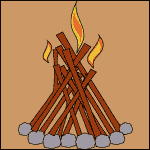Making a Tepee Fire
Created | Updated Feb 1, 2005

In a survival situation, four things are necessary: shelter, water, fire and food - in that order. The most efficient fire in such a situation is a tepee1 fire. Such fires are named after their shape, which is in the form of a cone.
Choosing a Location
Choose a place for the fire which is at least 15 metres (50 feet) away from water and 3 metres (10 feet) away from a shelter. Avoid places under overhanging branches or under rocks, since branches could dry out and catch fire and the water in rocks could explode. It might be worth digging into the ground to make sure there are no root systems which could carry a fire underground and spread it. Also avoid dry grassland, which could spread a fire.
If possible, look for somewhere with natural wind buffers, such as bushes, rock outcrops or fallen trees. These should be far enough away to not present a fire hazard.
Clear brush and debris away from the area and consider whether any of it may be suitable material for combustion later on.
Preparing a Fire Pit and Reflector
A fire pit is an efficient way of protecting the fire from the elements and of containing it safely. Dig down about 30 centimetres (one foot) and make a circular hollow with a diameter of about 60 centimetres (two feet) wide. Use a sharp stick or rocks if necessary. You can also put a circle of stones around the edge of the fire pit to give further protection to the fire.
A reflector is a high horse-shoe shaped wall of material which reflects back the heat and makes the best use of the heat from the fire and conserves firewood. The mouth of the entrance should be away from where the wind is blowing and should face where you are sitting. It can be constructed from rocks gathered from a dry area, damp firewood or sods or turves.
You should also consider preparing a pile of soil to be used in case the fire gets out of hand and escape routes if the fire really gets out of hand.
Gathering Firewood and Preparing the Fire
You will need to gather different types of firewood. Firstly, you will need the smallest, finest, driest, kindling you can find. This could consist of dried grasses, pieces of inner bark, frayed, tiny pieces of wood or other small plant material and fibres. Leaving a space to insert the tinder bundle or match to light the fire, begin placing small thin sticks against one another in a small tepee shape, adding layers of thicker and thicker wood up to the diameter of about four centimetres (1.5 inches).
It is recommended that dead standing tree is used rather than wood lying on the floor. Wood from the ground can be damp even though it looks dry.
This type of fire tends to light quickly and burn effectively as the wood feeds itself and it has a direct air supply. In bad weather a layer or bark of grass stalks can be used to protect the fire before lighting it.
Lighting and Maintaining the Fire
After you have lit your fire2, it is important to keep the tepee shape, so that the fire burns efficiently. This means placing the wood on the fire rather than throwing it on. Make sure that you have sufficient wood to feed the fire and do not leave it unattended. You will need enough wood so that you do not need to gather any during the night, which might be hazardous. Make sure to also clean the ashes out of the pit when it gets clogged.
The fire should be able to withstand bad weather, because of the efficient way that it burns.
For comfort, you will want to make a seat, maybe using a log or a pile of debris. Sitting on the ground directly could chill you. You might also want to think about a backrest, perhaps using brush and logs padded with debris. This will ensure that the side away from the fire does not become chilled.
Finally, when it is time to extinguish the fire, make sure that the fire is out. Pour water or soil on it, scatter the ashes and as far as possible restore the ground to how you found it, filling in the pit and scattering any debris around. Ideally, it should appear as though no-one has been there.

